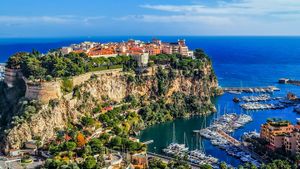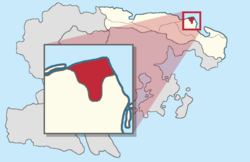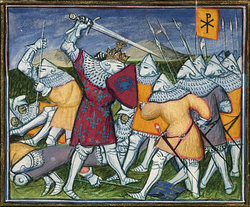Montcrabe City
Montcrabe City | |
|---|---|
National Capital | |
 A view of Montcrabe City | |
| Nickname(s): Pearl in the Pincer
( Anti-government saying. ) | |
| Motto(s): “Cunabula de crabelpince” (Crabin)
( Cradled by the crab's pincer. ) | |
 Location in Montcrabe | |
| Country | Montcrabe |
| Settled | 521 A.D. |
| Independized | 680 A.D. |
| Founded by | Julios Monscrabel |
| Named for | Mount of Crab |
| Government | |
| • Pravus Princi | Benjen Rothscrab
( Also Crabin Minster ) |
| Elevation | 98 m (322 ft) |
| Population (2018) | |
| • Total | 7.1 million |
| Demonym(s) | Crabin |
| Time zone | AMT-2 (AMT) |
| Area code(s) | 001 |
| Website | montcrabecity.gob.mtc |
Montcrabe City, (Crabin:Monscrabel Capel) officially the Prince's Municipality of Montcrabe (Crabin:Principati' Mudifice de Monscrabel), is the capital and second most populous city of the Principality of Montcrabe. According to the 2023 census, the city has a population of 7.1 million people, made up almost entirely by members of the Crabin ethnic group (despite it being a minority in the country overall). It is located in the Mount of Crab (Crabin:Mont Crabel), originally a settlement and hideway founded by the Romanyan Empire's oligarchs, it expanded into a full administrative region independent of Cospania and Savotta after the fall of the Empire. Even after countless failed incursions by the Savottans and muslim conquerors, it remained an independent beacon of independence. Montcrabe City is home to numerous landmarks, such as the Notre-Crabel Cathedral, the Vault of Savotta, and the Principati' Palacio. The city also serves as one of, if not the biggest harbor and trade port in the Romanyan sea.
The city is currently headed by Benjen Rothscrab, who also dually serves as the Crabin Minster of the country due to some unanswered legal loopholes regarding his term-for-life in both positions. As the seat of the royal family, albeit, his position as Pravus Princi for the capital is mostly ceremonial, and most decisions or changes are handled by the Principati himself.
History
Settling of the Mount of Crab
Montcrabe City, originally known as the "Coast's Pearl" or "Mounteicoste" by locals, was first settled by the Romanyan Empire in 521 A.D. as an exclusive coastal home-club for the absurdly rich oligarchs of the empire. With over 150 indentured servants and commodities to go with, it is said three different emperors visited the settlement, one of whom drunkedly proclaimed Mounteicoste the "capital of happy(ness)". The eventual takeover of the palace by Julios "Pincer" Monscrabel and his Romanyan soldiers in hunting for a muslim spy in 674 A.D. led to the construction of military camps and villages around the large mountain structure, and its adaptation as Julios' base of operations for the campaign against the mutadinuns in the North. A few months before Monscrabel's forces and their travels through the Romanyan sea were scheduled to take place, though, word arrived of the Empire's collapse in 680 A.D., and a wave of refugees was in-taken by the then-named "Fort Montcrabe". Transformed into a highly-militarized safe-haven for Latin aristrocrats, as led by Julios, the city received waves of funding to upgrade it into something truly befitting of a new Romanyan society by its residing oligarchs.
Early History & Savottan Incursions
A thriving and independent settlement, 14 years after the historically-recognized collapse of the first Romanyan Empire, a Savottan envoy and commander named Cesino Balatro arrived to the city and demanded Julios' subjugation as a vassal to the self-proclaimed new Romanyans in Savotta. The laughter by courtiers and servants of the Principati that erupted following the diplomat's spiel was said to have shaken the very core of the fortified palacio, and he was mocked all the way out to the city gates in tears. Balatro returned with five and a half thousand soldiers a few months later, as authorized by Governor Romero Bolada, marking the first of three attempted Savottan incursions into Monscrabel Capel.
Balatro agreed to meet with Julios' presumed heir and military marshal, Aerio I Monscrabel, before the battle. His attempts to find compromise and avoid a brutal siege in exchange for vassalization were simply met with a stalwart Crabin sentiment, and some more laughter to rub salt on the wound. Cesino's rage at the mockery is said to have pushed him over the edge, attempting to kill Aerio before himself being slaughtered in the diplomatic tent. The First Incursion began as soldiers spotted Aerio's entourage fleeing the tent, headed back into the city walls. With Governor Bolada spectating in the distance, the order was given to chase them down, as opposed to settling down for a siege. Well-armored soldiers scrambled to random positions in a haphazard attempt to breach the fully-manned city walls. Such lack of preparations turned attempted breach of the fortified mountain led to the slaughter of over a thousand soldiers, hundreds of knights and the capture of two Savottan nobles. Word of their public execution at the hands of Aerio himself reached the capital of Savotta, and yet another incursion was called upon.
The Second Savottan Incursion, as commanded by an unknown general, began in less bloody terms. Now with more soldiers and more of a stake to success, the Savottan commander was able to reach compromise with the Monscrabel Dynasty for monthly taxes and crops to be provided to the Savottan capital, even if not under the title of vassalization. As is now known, the Crabins never had the intention to abide by these terms. The time that the faux-agreement had bought them was used to further reinforce the city and prepare for a long siege, specifically in building a Montcrabin navy that could protect trade routes and the capital's ports.
Two months passed, and the Savottans caught on to the broken oath. The Savottan general (his name lost to time) returned to the reinforced city and built wooden fortifications and trenches right around it. A full year's siege came, and albeit very little action was seen on the ground, the Romanyan sea became a firey and bloody battleground in pursuit of control over Montcrabe's trade routes -- which had kept its people fed through the siege. The newly-built and untrained Crabin navy struggled to push back the seafaring incursion, and in 697 A.D. the Savottans established a naval blockade around the city's harbor. What might've marked a Savottan success was met with the appearance of Islamic Zuhraid corsair fleets in their attempts to regain a foothold in Sur. Shattering through the Savottan navy, the Zuhraids inadvertently broke the siege of Montcrabe and allowed for the nation to resume its much-needed supply runs. The land siege, too, was halted -- with orders from the capital instructing the armies to relocate themselves East and deal with the incoming Islamic raiders.
Free of the Second Savottan Incursion, worries over Julios' growing age and the issue of succession were brought to court. Julios' firstborn son and veteran of the Savottan Incursions, Aerio I Monscrabel, was named Heres Présom of the Principality. Once ceremonies had ended and oaths had been sworn to the new heir, Julios "The Pincer" Monscrabel called upon all of his vassals and aristocrats for what was labeled a "kingdom-changing" event. There, the proud and stalwart first Principati of Montcrabe, to the shock of all present, stabbed himself repeatedly. Amid gurgling blood, he declared: "I feel comfortable in my actions, and I wish die by my own hand -- not that of a Savottan. Let this throne be stained with the blood of-", before succumbing to his self-inflicted wounds. Some accounts allege him finishing his speech with "the blood of independence", some others with "the blood of this nation". It is most agreed upon by historians the proud Julios quite simply died before finishing his historical proclamation, nonetheless different versions of it are consistently found throughout pieces of Montcrabin architecture.
Aerio Monscrabel was crowned a week later by a peasant he himself had handpicked. The idea was spread that Aerio's crowning by a peasant meant a new age of equality for Montcrabe, but many accounts allege the peasant was killed a few hours later after stumbling upon the first council meeting, where military strategies were being discussed. Merely theatrics, indeed, as Aerio's policies closely resembled those of his militaristic and ironfisted father. His leadership is seen as one of order and military development, with the adaptation and implementation of Savottan military strategies and the increased funding of well-trained professional soldiers and a new navy. Such changes and reform caused hesitancy for a third incursion in the upper echelons of the Savottan Empire's military, and it was agreed the next attempt to subjugate the rebel city would be one of intrigue.
Soon came the Third Incursion, called such moreso for simplicity's sake. Truly, it involved no military action, but the intrigue of Savottan liaisons, spies and assassins that had infiltrated the Crabin aristocracy with the recent changes in leadership. Instructions delivered by hawk (others allege ravens, or even secret tunnels underneath the city), the Savottan spies were instructed to incite mayhem and murder in Montcrabe's royal court the following full moon. Once it came, so did havoc. Described by historians as a skirmish of knives and cutlery, loyalists and traitors separated into sects to make for a well-dressed skirmish within the palace walls. Whatever object could be used as a weapon was happily taken by servants and paid agents of either side. The incursion's main target, Aerio Monscrabel, albeit, was nowhere to be found. Ending in the death of almost all 24 aristocrats involved, save for some who were still sleeping as the brawl sparked, the Savottans abandoned their efforts of subjugation and left Montcrabe to be Montcrabe once and for all.
Middle Ages & the Misarchived Tricentury
Montcrabe City saw an astonishing economic boom for the next few centuries as peace with the Savottans and truces with muslim conquerors (a decision, shocking, to other Sur kingdoms) were reached. A surplus of statues for each ruler that came, a massive and well-trained navy to protect the growing trade-ports in the city, and an exponentially growing population. Though, Montcrabe never was built big enough for its growth, and so in 1347 A.C., expeditions were called upon for the Principality's expansion. As raids and wars of conquest were carried out against independent settlements and tribes in the northern coasts of Sur, the collapse of the Savottan Empire in 1350 A.C. caused many radicals to call for the Principality's expansionist efforts to be redirected south -- to the recently-sacked city of Savotta. The Crabelmeister Council, a mostly advisory institution, was founded a year later by the Principati, Elvi Monscrabel. Made up of 50 aristocratic representatives and scholars, they were all summoned in the Principati' Palacio to debate amongst themselves and reach a consensus in regards to invading the splintered Savotta. After five weeks of near-violence and passionate arguments, the council could not reach a conclusion, proving a vital step toward solidifying the modern anti-democratic sentiment and dictatorship present in Montcrabe. Elvi Monscrabel ruled no invasion of Savotta was to take place, and promptly disbanded the failed council.
Newly-established vassals throughout the coast, and the taxes that came with, further bolstered the unprecedented growth for the capital. Albeit, not many details in the city's history are well-recorded in this period (partly because historians were lured away from their scholarly professions to engage in the growing number of brothels and astoundingly well-stocked leisure palaces of the city, or even open their own, in a period known as the "Misarchived Tricentury"). Simply put, it was a time of opportunity and unbridled prosperity for the Principati's subjects. The lack of records (at least ones that do not conflict eachother), though, leave doubts as to the true identities of the Principality's next 7 rulers after Elvi Monscrabel.
Early Modern Ages & the Crabicunt Schism
Controversy, and the end of the Misarchived Tricentury, came by in the early days of the year 1657 A.C.. Principati Orys I Monscrabel, in a set of decisions best described as brazen, established a tax on alcohol and vices traded in the capital. Scholarly (and religious) types were offered a place of relevance in the Principati's court, and hefty rewards to go with. Leisure-palaces were raided and labeled "unholy" by the well-religious new ruler (some historians allege these businesses were simply handed off to closer allies of the Monscrabels, and given protection by the Principati's military), and churches were erected where construction projects once were planned. Such sudden change in policy was met with division: staunch supporters of religious enforcement, and the aristocracy (backed, mostly, by the vice-addicted populace). Alas, it marked the beginning of the Crabicunt Schism (1657-1663) in Montcrabe.
Following the six-year schism between the Crabelics and Aristocrats in Pereolocusta, Principati Baggio called for accords to be held in the nation's capital. In a bid to sway the aristocracy back under Monscrabel favor, and in a show of rebellion to his abdicated father's wishes, Baggio had the Crabelic Cardinals kidnapped upon their attendance and buried in a then-secret plot to cripple the church. A two-week meeting, marketed to the public as peace discussions (including paintings and sculptures by known artists), was held with the aristocracy to discuss the country's future and plan of action to end the schism soon thereafter. The highly religious populace of Perelocusta were soon targeted, often in churches and lower-classed communities, with various vices snuck into their water supplies and food shipments. Drugged into submission and compliance, Montcrabe saw the eventual dissipation of religious fervor and the end of the Crabicunt Schism. Private mercenaries re-captured former brothels and bars, and the ban on alcohol and vices was eventually lifted by the Principality.
The effects and unorthodox methods to force Montcrabe's population into submission at the end of the schism are subject to modern debate and discussion. Nonetheless, it is commonly agreed that Baggio's ruthlessness in censoring the public and religious fervor led to the death of thousands by means of overdose or execution at the hands of private aristocratic mercenaries. Various cities across the Principality still suffer the consequences of the compliance operation. An era of aristocratically-guided enlightenment and secularism took root within the affected regions, scholars often bribed with vices to create innovations in science and technology. An outpour of intellectual accomplishments, in conjunction with an intranational renaissance of art and culture through the aristocracy's extortion of influential artists and public figures, paved way for Montcrabe's later ages.
Late Modern Ages & the Folkonian Intrigue
Montcrabe's enlightenment and cultural reformation under Principati Baggio drove the Montcrabin industrial revolution, a period of profound change in the socioeconomic landscape of the Principality, resulting in industrialized agriculture, manufacture, engineering and mining, as well as rail and water networks in Montcrabe City to facilitate its expansion, trade and development. Perelocusta particularly saw a boom in growth under the industrial revolution, then dubbed as the "Worker's City". Thousands of workers migrated from the countryside to find better-paying jobs and settle in the growing industrial settlements. Montcrabe City, albeit, reaped most of the benefits. By then closed off from the public as a city exclusive to aristocrats and middle class Montcrabins, railroads were built with heavy biases toward the growth and wealth of the capital. A common worker's saying, "all railroads lead to Montcrabe City", was thus born.
The rapidly deteriorating working conditions in the Eastern reaches of Montcrabe caught the attention of the Folkonian Empire across the Romanyan sea. Sensing it a great opportunity to cripple Montcrabe's hegemonic naval dominance over the channel, the Empire assembled some expeditionary forces meant to sow discontent and chaos in the Principality's industrial centers. A small fleet was sent, and began the covert dissention campaign - albeit unaware of Montcrabe's vice-fueled sway over its own people. Word of the operation soon reached the capital, from the mouth of countless addicts, and Crabin Forces were transported to the region. The Folkonian Empire's expeditionary task force was found out, and its members publicly executed, before the Principality hatched its own intrigue mission into its Northern rival's territory.
Two scholars, spies under the payroll of Principati Baggio, were dispatched to the capital of Folkon. Soon using their wits and connections to become high-ranking advisors of Emperor Makon I, one of the spies found it a more profitable proposal to retain his position and betray the Principality. Thus, he snitched on his partner, leading to his summoning at the Emperor's court. The allegations levied against the spy, today known as the "Lost Sailor", prompted him to attack and murder his former partner and the Folkonian Emperor. Fleeing from the palace and capital by boat, his escape was successful. A small Montcrabin fleet soon found his raft in the midst of the Romanyan sea, alongside a journal - but no body.
The theory heralded by the Montcrabin government is that the Lost Sailor fell asleep and rolled out of his raft in the night - with a hefty reward offered to anyone who can find his remains. Many historians, albeit, allege that the Lost Sailor made it back to Montcrabe City, where he was executed to seal the secret of the Folkonian Emperor's assassination (including Montcrabe's involvement). The following collapse of the Folkonian Empire reaffirmed Montcrabin naval dominance over the Romanyan sea.
Throughout the 19th century, Montcrabe remained mostly isolated from the rest of the world. A distinct and remarkably well-enforced ban on emigration was put in place, paired with some minor worker's benefits throughout the years to pad the outrage. The Principality's overarching century-long project to subdue and keep its people in check saw itself aided by the culminating Montcrabin enlightenment and the technologies it came to provide: Industrial printing presses mass-producing propaganda, the eventual arrival of the radio to every workplace to transmit state-sponsored messages, and the reorganization of government into a more modern and powerful institution. Constant economic growth, as opposed to one boom or event, led to the continued reinvestment into Montcrabe City and its rebranding as a true metropolis. "Earn the right to Montcrabe City" was constantly fed to lower-classed citizens as an ultimate goal in serving their country through otherwise abusive industrial jobs and military service, which itself had been deemed mandatory for all men aged 17-20 by the 1870s. A slow-paced and yet stable era of prosperity, until the contemporary age.
Contemporary Period
Text
Demographics
Population
Text
Ethnic groups
Text
Government and politics
Government
Text






